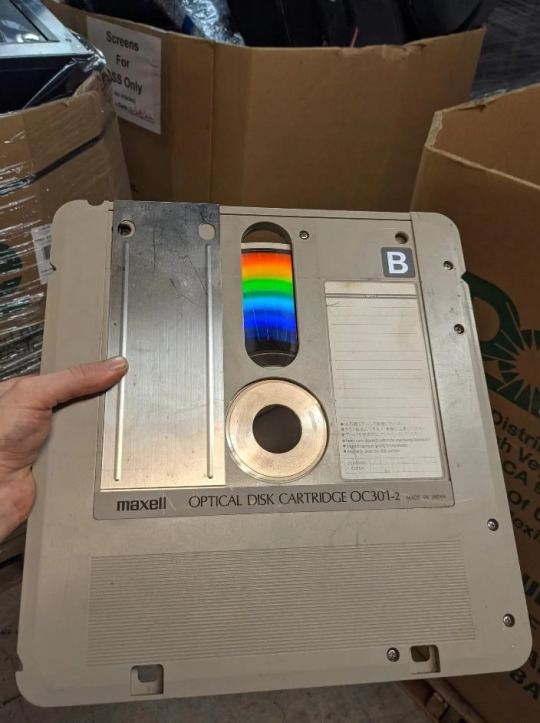#CED Videodisc
Explore tagged Tumblr posts
Text




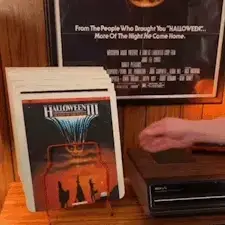

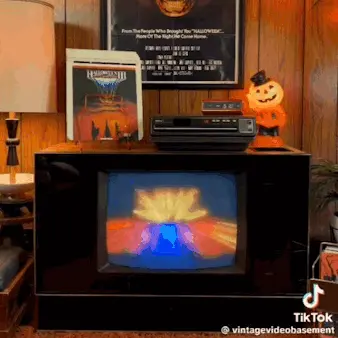



📺🎃Halloween III on CED Videodisc🎃📺
#stimboard#moodboard#stim#halloween#tv#vintage tech#old tech#ced videodisc#flashing tw#screen#flashing lights#jack o lantern#pumpkin#brown#black#orange#blue#glitch effect#glitching#retro
60 notes
·
View notes
Text



Th CED Movie Night was a big success! Many thanks to our host In the Pines Studio!
1 note
·
View note
Note
SO JEALOUS OF YOUR MEDIA COLLECTION obsolete media formats georg over here!! question: do you know about videodisc/CEDs? i see them all the time and they're fascinating to me
Aw man, yeah. I wanted them SO BAD when they came out but my mother (quite indulgent towards my media pursuits) wasn't buying it, and I can't blame her. Regular LDs definitely looked to be the better technology (and in the end were) but at the start, the selection of titles in CED was massively superior to them (and even tapes at that time!).
So, I never got 'em. Though I do have two friends who did, and still have working players and BIG disc collections. Used to watch them with one friend, but rarely, as the discs do seriously wear out and one doesn't want to risk breaking the player by using it too much (I think most owners now have become skilled repairers of the touchy things)
A much-beloved and remembered piece of home video history!
4 notes
·
View notes
Text

06/19/24: It's once again Wednesday and my fleamarket buys. A lot of stuff was a repeat of last week. So I didn't buy from them. But I did get stuff from other spots. My first buy was for $10; a Tiger Handheld LCD game, a DS game, and two graphic novels. Next place, I got a Samurai martial arts movie for a dollar. Last week I found a Muppets dvd and this week I found the rest of the series, plus a few others . I think I got someone else's Muppet collection now. The seller last week must have not brought out everything until today. I also got from him a mini wooden chest, a strategy guide for the game Ni No Kuni Wrath of the White Witch, and a movie from a dead format. War Games on CED. The man also had more of these, but this movie was the only one that caught my attention. He had some late 70s early 80s movies. And some Roger Moore 007 ones. Maybe next week I'll get them. Anyway, total for all of it was $14.00. The last thing I bought looks decent, but has a defect. But for the price, I'll take it anyway. A red n64 controller for $5.00! It's got a few scuffs and scratches. But it's major flaw is its analog stick. It's quite bent. It's not completely broken and floppy, but it's shaft is bending in a weird way. But I'm still taking it, I'm fairly sure I can replace it. And so ends another week of fleamarket finds.
#flea market#fleamarket finds#videogame collecting#videogames#dvd collecting#bluray collecting#the muppets#graphic novels#war games#CED#rca videodiscs#n64 accessories#tiger handheld#strategy guide#ni no kuni
1 note
·
View note
Note
so you're in support for art theft? answer instead of deflecting like you always do
The Capacitance Electronic Disc (CED) is an analog video disc playback system developed by Radio Corporation of America (RCA), in which video and audio could be played back on a TV set using a special stylus and high-density groove system similar to phonograph records.
First conceived in 1964, the CED system was widely seen as a technological success which was able to increase the density of a long-playing record by two orders of magnitude.[2] Despite this achievement, the CED system fell victim to poor planning, various conflicts with RCA management, and several technical difficulties that slowed development and stalled production of the system for 17 years—until 1981, by which time it had already been made obsolete by laser videodisc (DiscoVision, later called LaserVision and LaserDisc) as well as Betamax and VHS video cassette formats. Sales for the system were nowhere near projected estimates. In the spring of 1984, RCA announced it was discontinuing player production, but continued the production of videodiscs until 1986, losing an estimated $650 million in the process. RCA had initially intended to release the SKT425 CED player with their high end Dimensia system in late 1984, but cancelled CED player production prior to the Dimensia system's release.[3]
The format was commonly known as "videodisc", leading to much confusion with the contemporaneous LaserDisc format. LaserDiscs are read optically with a laser beam, whereas CED discs are read physically with a stylus (similar to a conventional phonograph record). The two systems are mutually incompatible.
RCA used the brand name "SelectaVision" for the CED system, a name also used for some early RCA brand VCRs,[4] and other experimental projects at RCA.[5][6] The Video High Density system is similar to that of CED.
18 notes
·
View notes
Text
1983 | Michael Jackson - "Billie Jean"
Y'all know that thing when you're a kid, and you notice there's this really cool, fashionable thing all the other kids are wearing at school, and you go home and ask your folks for the fashionable, exciting thing so you can be cool?
But then your folks buy you the thing that looks sorta like the fashionable, awesome thing, but is very obviously not that?
Let's just say the parachute pants I requested were not parachute pants.
Eh, I got over it.
Our nextdoor neighbors had "Making Michael Jackson's Thriller" on something called Selectavision. Us kids would go over there and watch it all the time. They also had Dark Night of the Scarecrow. I think they owned like five SelectaVision discs in total, so there was not a lot to choose from. But holy shit, I never got tired of watching John Landis and Michael Jackson collaborate on that video.
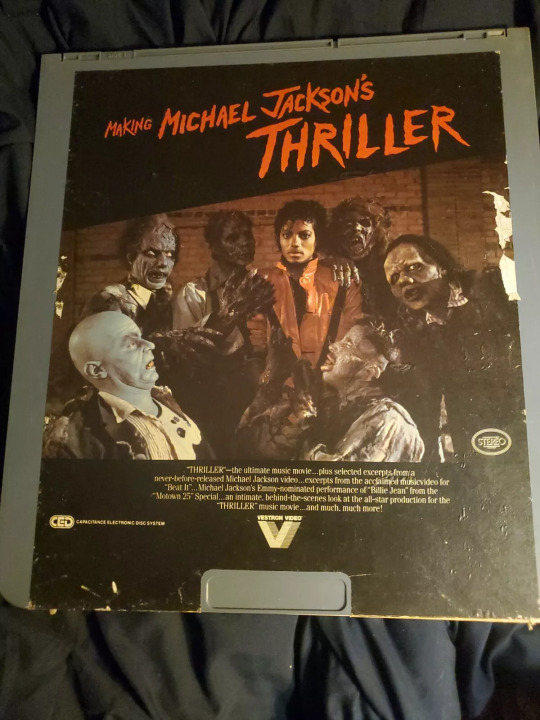
I was almost as curious about the SelectaVision.
They looked like giant flat 8-track cassettes to me, and I had no idea how they worked. These weren't laser discs. They were a competing format that had come out earlier. The SelectaVision discs were packaged inside a giant plastic case (like a big 3.5" floppy disk). These Capacitance Electronic Discs (CEDs) were developed by RCA as an updated analog format. They worked very similarly to vinyl records. From Wikipedia:
"First conceived in 1964, the CED system was widely seen as a technological success which was able to increase the density of a long-playing record by two orders of magnitude. Despite this achievement, the CED system fell victim to poor planning, various conflicts with RCA management, and several technical difficulties that slowed development and stalled production of the system for 17 years—until 1981, by which time it had already been made obsolete by laser videodisc (DiscoVision, later called LaserVision and LaserDisc) as well as Betamax and VHS video cassette formats."
Anyway, where was I? Oh yeah, Billie Jean is one of the best songs of all time. Like maybe top five. Certainly top 10. His performance of the song on network TV was like a Gen X Beatles-on-Ed-Sullivan moment. And while we'd all learn more about Michael Jackson than we ever wanted to, all 1983 me knew about 1983 Michael Jackson was that he was the coolest human alive.
Of course, that was right before I learned about Prince.
0 notes
Text
youtube
RCA 1984 Video Systems CED Videodisc
0 notes
Photo
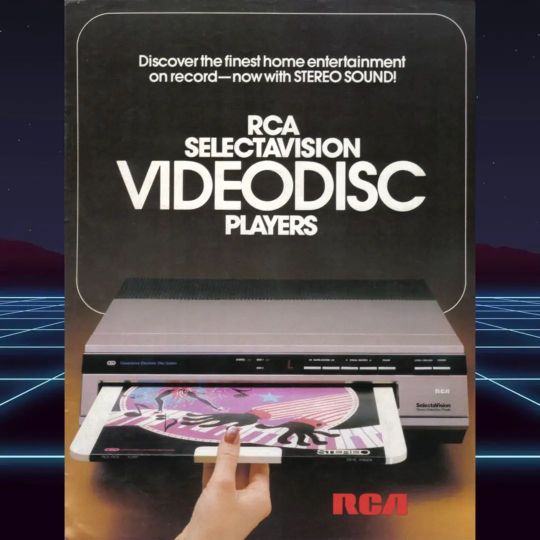
Lecteur ced selectavision -RCA Conçu pour la première fois en 1964, le système CED (disque électronique capacitif qui est un système de lecture de disque vidéo analogique) était largement considéré comme un succès technologique. #electronics #electronic #electronicvintage #vintage #vintagestyle #vintageelectronics #ced #videodisc #retro #retrowave #retrotechnology #60s #70s #70stechnology #80s #80stechnology #rca #selectavision #synthwave #newretro #newretrowave #technology #retrotechnology #vintagetechnology #technologyvintage (à Troyes, France) https://www.instagram.com/p/Ch7mP9eNYmC/?igshid=NGJjMDIxMWI=
#electronics#electronic#electronicvintage#vintage#vintagestyle#vintageelectronics#ced#videodisc#retro#retrowave#retrotechnology#60s#70s#70stechnology#80s#80stechnology#rca#selectavision#synthwave#newretro#newretrowave#technology#vintagetechnology#technologyvintage
1 note
·
View note
Text
Oh man, it's on a frickin CED videodisc, also known by the format's brand name, "SelectaVision." This is not a videodisc as we think of it today, read by lasers. No, this is a 12-inch grooved disc, like an LP record, played with a stylus. These are whole movies being played on a television set with a needle and tone arm. However, because video is inherently more complicated and involves way more data than sound does, the grooves had to be very, very tiny to be able to pack a whole film onto one disc (and even then, the disc usually had to be flipped partway though to watch a movie in its entirety).
The problem with this? Since the grooves were so tiny, they were also incredibly fragile. One speck of dust could cause the movie to skip--heck, even a fingerprint could sometimes do it. Hence, the case you see in the picture above was also the delivery mechanism by which the disc was inserted into its VCR-like player. The whole case was inserted into the player, which would grab hold of the disc and the protective plastic ring around it, and then the empty case would be pulled out again. When the time came to remove the disc from the player, the process would repeat in reverse. At no point would the disc ever be directly touched by human hands, because to do so would potentially destroy it.
If this all sounds like a terrible idea, consumers in the 1980s thought so too. The idea was revolutionary when RCA first thought it up in 1964, but by the time they actually got around to making SelectaVision discs available to the public in 1981, said public had already gotten used to VHS/Beta videotapes and LaserDiscs, neither of which could be rendered totally useless by something as trivial as dust or fingerprints. Essentially, SelectaVision was obsolete before it even came out.
When it became clear that SelectaVision had been soundly defeated by its home video competition, RCA announced in 1984--three years after the format's introduction--that they would no longer sell the players. For whatever reason, however, they still continued to manufacture the discs for another two years, although it's unclear how they expected to recoup the costs when they had already lost hundreds of millions of dollars over the course of SelectaVision's doomed lifespan. Ultimately, RCA's stubborn insistence on clinging to the development and manufacture of this format proved to be their downfall. In 1986, the legendary Radio Corporation of America was sold to GE, and most of its assets were liquidated.
In short, the videodisc in the image above is emblematic of two Reagan-era phenomena: the last gasp of the Cold War; and the first casualties of the home video war.

179 notes
·
View notes
Photo
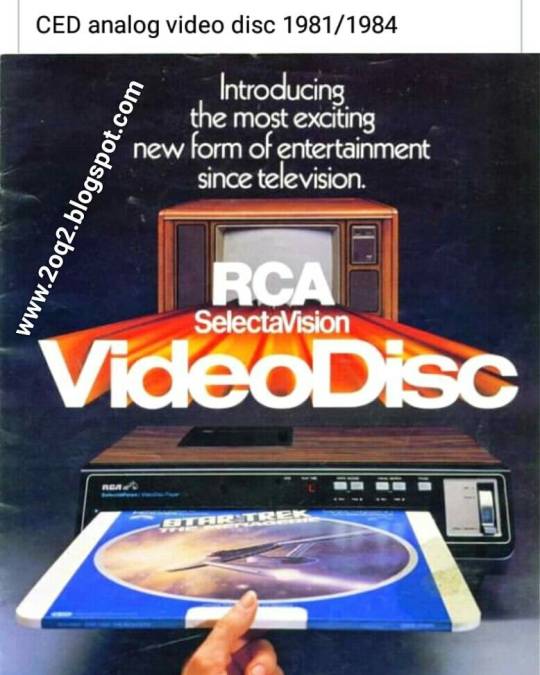
CED analog video disc 1981/1984 . #CED #analog #video #disc #Year1981 #Year1984 #Ano1981 #Ano1984 #VideoDisc #Analogico #Entretenimento . . ... https://www.instagram.com/p/CTOX7UQsAj9/?utm_medium=tumblr
0 notes
Photo

The Challenge (1982) CED Videodisc . . . . #vhs #vhscollector #vhscollection #retrocollector #retrocollective #vhstape #ced #videodisc #80smovies (at Seattle, Washington) https://www.instagram.com/p/CChWbynF0Fs/?igshid=1kodwilnl1f7
0 notes
Photo

Cartoon Classics, Volume 2: Pluto
1980s CED videodisc

6 notes
·
View notes
Video
RCA SelectaVision VideoDisc and my Zenith SelectaVision player part one ... https://hubpages.com/technology/The-Amazing-RCA-SelectaVision-VideoDisc-Players ... The remarkable RCA invention of the Capacitance Electronic Disc took a long time to make it to the public. The RCA SelectaVision system is better known as a vinyl (CED) Disc; this disc was a remarkable designed system that was a state of the art analog video disc that was a playback system that was developed and created by RCA. With this system the video and audio could be played back on a television console using a special diamond needle, and a very detailed, and fine high-density groove system similar to the long playing phonograph records. RCA SelectaVision VideoDisc
1 note
·
View note
Note
Why is posting "cishets don't interact" not prejudicial discrimination?
The Capacitance Electronic Disc (CED) is an analog video disc playback system developed by Radio Corporation of America (RCA), in which video and audio could be played back on a TV set using a special stylus and high-density groove system similar to phonograph records.
First conceived in 1964, the CED system was widely seen as a technological success which was able to increase the density of a long-playing record by two orders of magnitude.[2] Despite this achievement, the CED system fell victim to poor planning, various conflicts with RCA management, and several technical difficulties that slowed development and stalled production of the system for 17 years—until 1981, by which time it had already been made obsolete by laser videodisc (DiscoVision, later called LaserVision and LaserDisc) as well as Betamax and VHS video cassette formats. Sales for the system were nowhere near projected estimates. In the spring of 1984, RCA announced it was discontinuing player production, but continued the production of videodiscs until 1986, losing an estimated $650 million in the process. RCA had initially intended to release the SKT425 CED player with their high end Dimensia system in late 1984, but cancelled CED player production prior to the Dimensia system's release.[3]
The format was commonly known as "videodisc", leading to much confusion with the contemporaneous LaserDisc format. LaserDiscs are read optically with a laser beam, whereas CED discs are read physically with a stylus (similar to a conventional phonograph record). The two systems are mutually incompatible.
RCA used the brand name "SelectaVision" for the CED system, a name also used for some early RCA brand VCRs,[4] and other experimental projects at RCA.[5][6] The Video High Density system is similar to that of CED.
104 notes
·
View notes
Photo


The Return of the King 1980 on CED RCA VideoDisc
with cover art that looks blatantly similar to the 1977 Star Wars poster
source: formerly on ebay
#ced#videodisc#rankin/bass#rankin/bass productions#the return of the king 1980#arthur rankin jr#jules bass#jrr tolkien#animated lotr
5 notes
·
View notes
